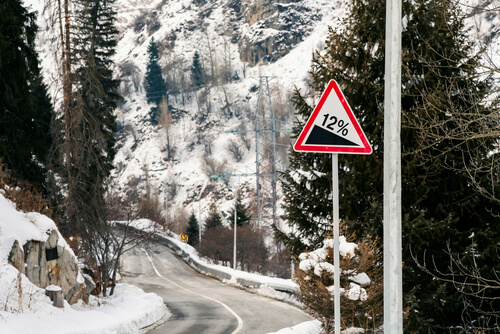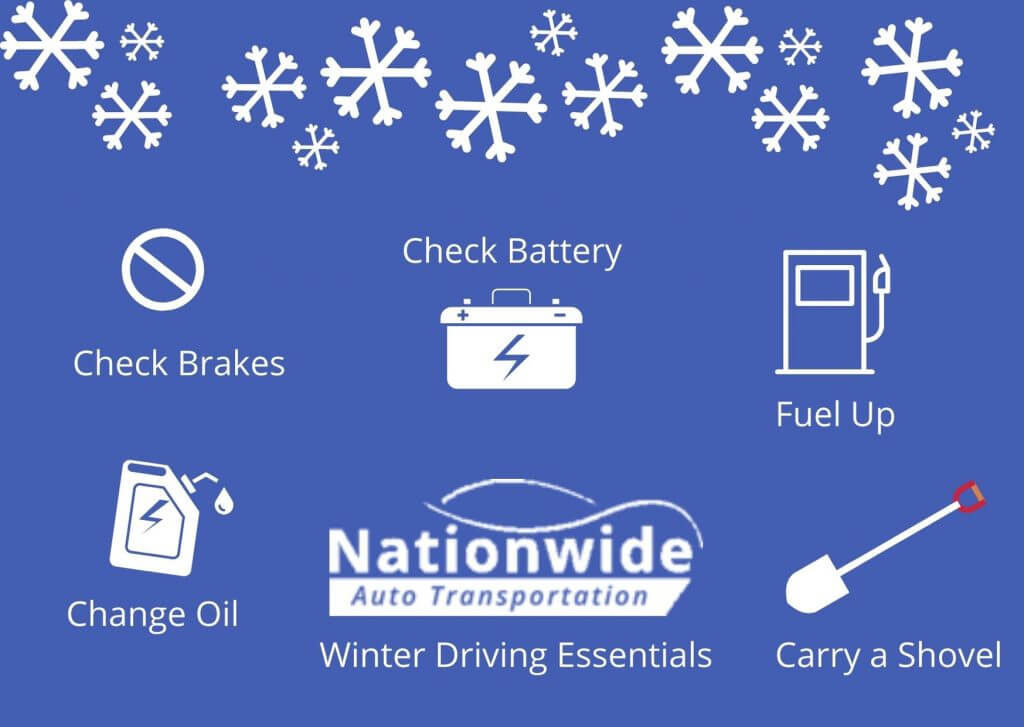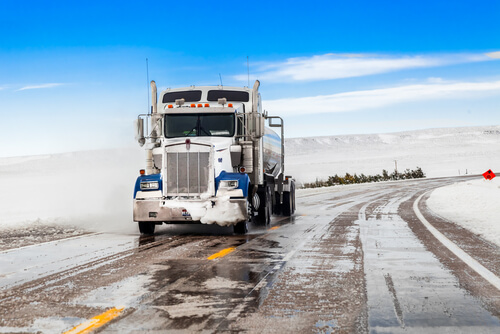
Reading Time: 9 minutes
People who live in areas that are covered in snow and ice for large parts of the year seem so confident about driving safely in the snow. Yet, for those who live in the warmer states, driving in severe weather can be a dangerous and frightening experience.
The AAA Foundation for Traffic Safety attributes approximately 500,000 crashes and 2,000 auto fatalities to bad weather, winter storms, and wet roads every year. That’s part of why there are so many driving safely in snow campaigns in New York city. In this article, we share some cold weather road tips to show you how auto shipping drivers continue delivering exceptional services on time while driving safely in snow and ice. Of course, you don’t want to miss our awesome winter driving infographic below…
Drive Tips for Snow and Rain
These tips were learned over years in the industry. Read our Starter Story to learn more about our company.

There are road rules, and then there are best practices for driving in snow and ice. Our drivers are on the road all year round, and they encounter storms, breakdowns, and all kinds of unforeseen issues. Not only do they know how to drive safely in snow and ice, but they also keep a number of other winter driving survival tips up their sleeves. Why? Because it is not unusual for these hardworking men and women to end up stuck on the side of snowed-in roads. Thankfully, they are always prepared and extra cautious in adverse weather conditions whether it’s holiday driving or auto shipping.
What should I pack to ensure I’m driving safely in the snow when traveling in winter?
Because long-haul truck drivers live in the living quarters behind the cabin of the truck, they know how to really kit out their trucks for comfortable habitation. During winter, they keep the following on hand for driving in snow and on icy roads (and they suggest you do the same!):
- Extra food and water
- Extra warm, dry clothing
- Boots (in case you have to leave your car)
- Blankets
- Medications
- A first aid kit
- Car emergency kit, including inflation repair kit, fire extinguisher, tow rope, jumper cables, and hazard triangle
- A glass scraper
- Snowbrush
- A shovel
- A flashlight
- High visibility kit, including a hi-viz vest
- A brightly colored cloth to use as a flag signaling distress in case of emergency
- Energy bars and dried fruit
- Extra batteries for phones, flashlights, and to power appliances
- Extra fuel, and never miss a filling station unless you have more than half a tank
- Sand or salt (optional)
Be Prepared to Drive in Bad Weather
Before setting off on your road trip, be sure to listen to the traffic and weather reports both locally and at your destination and be prepared for it. Being in tip-top shape physically (okay, maybe not Batman-level fit, but at least well-rested and thoroughly nourished) will definitely go a long way to ensuring you have the stamina and sustenance to keep doing whatever needs to be done to stay alive in the event of an emergency.
When you’re planning a road trip during winter, and you know you will hit wet, icy conditions, it’s important to plan properly. These suggestions are often incorporated in driving safely in snow campaigns in New York city and other snow states.
Snowy Suggestions
- Don’t drive until you’ve checked the tailpipe. If the exhaust system becomes clogged by mud, ice, or snow, it can cause carbon monoxide to leak into the passenger compartment while the engine is running.
- Ensure that the windows and mirrors are clearly visible before you get in the car. Scrape the windshield clean and apply windshield defroster as needed.
- Remove any ice from the radiator shutters, or, if you have a winter front, don’t shut it too tightly, as it could cause the engine to overheat and stop.
- Stay in contact with someone at your place of origin and someone at your destination. Let them know where you’re headed, your route, and when you expect to arrive at your destination.
- Only run the heater and engine long enough to remove the chill in order to conserve fuel.
- Don’t rush and over-exert yourself. Rather budget additional time to get to your destination if you’re driving in snow or rain.
- Be on the lookout for black ice. It is hard to see, but it usually makes roads look glossy or polished. It is usually found near high walls and under trees or other sheltered or shaded parts of the road. Then there’s that old saying, “hauling ass will land you in a cast”. Speed kills on wet, icy roads – even in a 4-wheel or all-wheel drive.
How to drive safely in snow conditions
Vehicle maintenance is always important, but if you’re going to be driving in snow or wet conditions, it’s even more crucial – it can literally save lives. Your vehicle could provide essential shelter when you’re stuck on the side of the road. Here’s how you take care of your vehicle in winter (in addition to our car winterization tips):
- Service and maintain – Before setting off on your journey, ensure that the vehicle is serviced, maintained, and that the engine oil viscosity of your vehicle is suitable for the expected weather conditions. Also, check the antifreeze is measured and topped up if needed.
- Check the brakes – Brakes save lives. Have your rotor discs and brake pads checked and if need be, replace them with high-quality brakes. Quality definitely matters in this case.
- Check your tires – Your tires are your contact with the road surface, and therefore, they need to be up to the task. Before setting off on your road trip, check the tread on all your tires (fitted and spare) and ensure that they are properly inflated. Rather spend the money on replacing your tires than risk lives. If snow or rain is forecasted for the time of your trip, seriously consider installing snow tires. It is not uncommon for lack of grip to occur; it commonly happens even on treated roads.
Keep Checking
- Always Check your lights and reflectors – Take your time to ensure that your headlights and taillights are in good working order. If any bulbs need replacing, do so to ensure that you are visible even in poor weather conditions.
- It is a good idea to Check your heating and defrosting equipment – These safety tools are only useful when they are in working condition and operated correctly.
- Check your wipers and washers – Your windshield wiper blades should be in good condition and the blades must press hard enough against the window to wipe the windshield clean.
- Save money on car rentals – If you’re undertaking your winter road trip in a rental car, don’t rely on all-wheel drive. Although four-wheel or all-wheel drives keep you moving on icy or snowy roads, they won’t prevent accidents altogether. Because they have a higher center of gravity, SUVs and all-wheel-drive trucks are more prone to rolling. On the contrary, some experts agree that careless driving in a four-wheel drive is more likely to land you deeper in the snow before you become stuck. However, driving responsibly in a four-wheel or all-wheel drive will certainly ensure better performance in winter driving conditions.

How to Drive Safely in Snow and Ice Road Conditions
You must take extra care when driving on wet, icy roads. For that reason, it is important to follow these safety guidelines:
- Don’t rush. Take your time to get a feel for the road.
- Adjust your driving to suit the road conditions. This would include your speed, space, turning, and braking. Do this by:
- Avoiding driving alongside other cars.
- Keeping a longer following distance. There should be three times more space than usual between you and the car you are following.
- Avoiding using overdrive or cruise control on icy roads.
- Slowing down and waiting for traffic jams to clear.
- Anticipating stops where possible and slow down gradually.
- Avoiding passing slower vehicles unnecessarily, and never passing sanding trucks or snowplows.
- Going slowly enough to see ahead of you, but fast enough to maintain a steady speed.
- Wondering how to how to drive safely in snow curves? Take curves at slower speeds and avoiding braking on curves.
- Slow down, even after the temperature rises enough for the ice to melt. At this point, roads become even more slippery.
- Avoid driving through flowing water or deep puddles. If you can’t avoid it, do the following –
- Slow down.
- Switch to a low gear, especially when you’re on a hill. Lower gears will help you to maintain traction.
- Infrequently traveled roads, overpasses, and bridges will often freeze first. Shady areas or exposed roadways (such as bridges) can become frozen if the conditions are cold and wet.
- Apply your brakes gently to prevent skidding. Ease off the brakes if the wheels start to lock up.
- Increase your revs per minute and keep light pressure on the brakes while crossing the water and for a short distance after. This will help heat the brakes up and dry them out. Driving with wet brakes can cause them to malfunction, leading to poor braking power, pulling to one side, and wheel lockups. Once you feel that the brakes should be dry, make a test stop. But first, make sure there’s no one behind you. If the brakes don’t work as they should, continue maintaining light pressure on the brakes to dry more.
Take Care in Adverse Weather
- Avoid making jerking movements with the brakes, steering wheel, and accelerator. Drive smoothly.
- Know how to use your ABS system. The ABS will start to cycle when you step on the brake. The pedal will pulse and you will hear it. Stay on the pedal and steer around the obstacle.
- Use cadence braking if your vehicle doesn’t have ABS brakes. The method for cadence braking is as follows:
- Apply the brake until the wheels stop rolling
- Immediately release the brake just enough to allow the wheels to turn again.
- Repeating this simple sequence rapidly will help the tires to produce maximum grip, regardless of the surface.
- Get to know your vehicle’s technology and ADAS features. Your owner’s manual will contain information about how to use the following systems when driving safely in snow and ice:
- Anti Lock Braking System
- Electronic Stability Control (ESC)
- Don’t power up hills. Your wheels can start to spin if you apply extra gas on icy roads. Instead, build up some inertia before you reach the hill and let that drive you to the top. Never stop while you’re going uphill.
- Assess your traction constantly. It will naturally adjust to changing weather conditions. Keep an eye on your anti-lock-brake system and stability-control systems to assess your level of grip on the wet roads.
- Let the lights guide you – that specific amber one in particular. It is the outline of a car, and behind it, are squiggly lines. If the light blinks when you accelerate while driving in a straight line, that means that your wheels are slipping. Ease up on the accelerator to allow the tires to regain their grip on the road.
- Look in the direction in which you want to go rather than where you’re headed or what you want to avoid. That’s a job for your peripheral vision.
- Know how to navigate slick spots. Most drivers hit slick spots from time to time, but that doesn’t erase the cold chill that goes down your spine at that moment. The good news is that they are easier than you think to handle. Keep a cool head, and do the following:
- If your front wheels lose grip and your car turns in a wider arc, simply ease off the gas and the front tires will regain traction.
- If your rear wheels skid, turn the steering wheel in the same direction in which the car is sliding, and ease off on both the brakes and accelerator.
- Use your anti-lock brakes correctly. Your car’s ABS is handy when all else fails while driving in snow and ice. If your car has ABS and you’re struggling to recover control and want to avoid colliding with an obstacle, push the brake pedal hard until you have recovered.
Warning: Avoid applying too much brake pressure at the same time as the accelerator to prevent overheating brake linings and drums.
EXPERT TIP: If it’s a luxury car, rather ship it. Take advantage of our seasonal deals.
What to do in a winter-driving emergency?
When you run into a slippery conditions and end up stuck in snow, these tips might help:
- Avoid spinning the wheels, as it will cause you to be stuck deeper into the snow.
- Turn the wheels from side to side to dislodge some of the snow from the sides of the tires.
- Touch the gas ever so lightly to help ease your car out.
- Shovel the snow away from the wheels and the undercarriage.
- Pour salt, gravel, or kitty litter in the path of the wheels to improve traction.
- Check the owner’s manual to determine whether it is safe to rock your vehicle backwards and forwards. Once in gear, gently touch the gas until the car moves again.

Most Important Winter Driving Tip
Long-haul drivers don’t get into this business because they love sitting at home or going to an office. No. Auto transport carriers are a rare breed of people who love what they do. To them, working with clients and impressing with their level of service is their passion. In a thriving yet competitive industry, owner-operated truckers have to outbid one another to secure fares to fit on top and bottom racks. That means that – like most other people – they have to work hard for their money. It’s long hours day after day and more than 300 nights a year away from home. But for them, the real reward is being able to travel across our beautiful country.
These truckers see a lot, especially when driving on wet roads. They have a few final words to share with you, our dear reader, and would appreciate you passing the message on to your loved ones. (Please use the share buttons below to do so…)
“If you can stay home this winter, please do. Keep any trips to the absolutely necessary. You might know how to drive safely in snow and rain, but it is best to avoid any unnecessary risks by going road tripping in winter. Keep that ultimate road trip across the country for summer. Don’t become one of those stranded motorists who keep emergency services busy away from real emergencies.”
Navigating the Process | How to Ship a Boat Internationally is a great read if you are thinking of relocating overseas.



